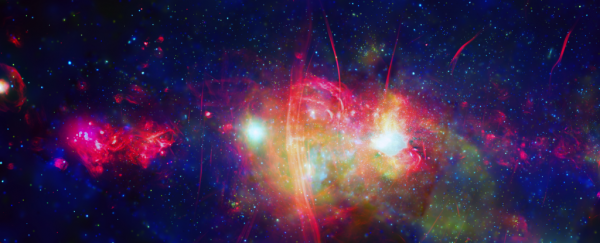Near the centre of the Milky Way, in a vast cloud in the space between the stars, astronomers have identified an organic molecule never before detected in the interstellar medium. It's called propargylimine, and it could play a key role in the formation of the amino acids vital for the emergence of life.
"The peculiarity of this chemical species lays in its carbon-nitrogen double bond, which gives it a high reactivity," explained astrochemist Luca Bizzocchi of the Max Planck Institute for Extraterrestrial Physics in Germany.
"With this double bond, it becomes a fundamental constituent of the chemical chains that lead from the simplest and most abundant molecules in space containing carbon and nitrogen - for example formaldehyde (H2CO) and ammonia (NH3), respectively - to the more complex amino acids, the fundamental building blocks of terrestrial biology."
The region in which the molecule was found is a system of clouds rich in molecular gas. It's called the Central Molecular Zone, an area of intense interest to astrochemists. It's a large repository of astrophysical complex organic molecules, such as ethyl formate, iso-propyl cyanide and propylene oxide.
These are known as prebiotic molecules, since they play a role in the prebiotic processes that create the building blocks of life, such as amino acids, RNA, and DNA.
As Bizzocchi noted, propargylimine can also be pretty important for these processes - molecules with a double carbon-nitrogen bond play an important role in a chemical process called the Strecker synthesis, used to create amino acids in laboratory settings.
In addition, propargylimine is structurally similar to a number of organic molecules that have already been identified in space. So, Bizzocchi and his team decided to go looking for it. But first, they needed to know what to look for - and that meant studying the spectrum of propargylimine in a lab.
You see, when light passes through a molecular cloud, the molecules in that cloud absorb and re-emit electromagnetic radiation at specific wavelengths, resulting in what we call absorption and emission lines on an electromagnetic spectrum.
Each molecule has its own configuration of these lines, like a chemical fingerprint, but you need to know what that fingerprint looks like in order to identify it.
"As a molecule rotates in the interstellar medium it emits photons at very precise frequencies," Bizzocchi explained. "This information, when combined with data from radio telescopes, allows us to know whether a molecule is present in the molecular clouds, the sites of star and planet formation."
So, the team recorded the rotational spectra of two isomers, or atomic configurations, of propargylimine in the laboratory, adding up to around 1,000 rotational transitions. This allowed the team to compile a highly precise spectral profile of propargylimine, accounting for the distortion the molecule undergoes in space.
The next step was to compare these results with spectral observations. These observations were taken using the 30-metre telescope in Sierra Nevada, Spain, and focused on a cloud in the Central Molecular Zone called G+0.693-0.027.
And sure enough…
"Our molecule was already there," said astrophysicist Víctor M. Rivilla of the National Institute for Astrophysics in Italy.
"It was laying in our data of the G+0.693-0.027 molecular cloud, but we couldn't identify it without knowing its precise spectroscopy, that is the full description of its emission frequency pattern. As soon as we got it, thanks to the measurements in the laboratory, we realised that the propargylimine was undoubtedly there, waiting for someone to recognise it."
Who knows what else might be out there, waiting for us to figure out how to see it?
The research has been accepted in Astronomy & Astrophysics, and is available on arXiv.
